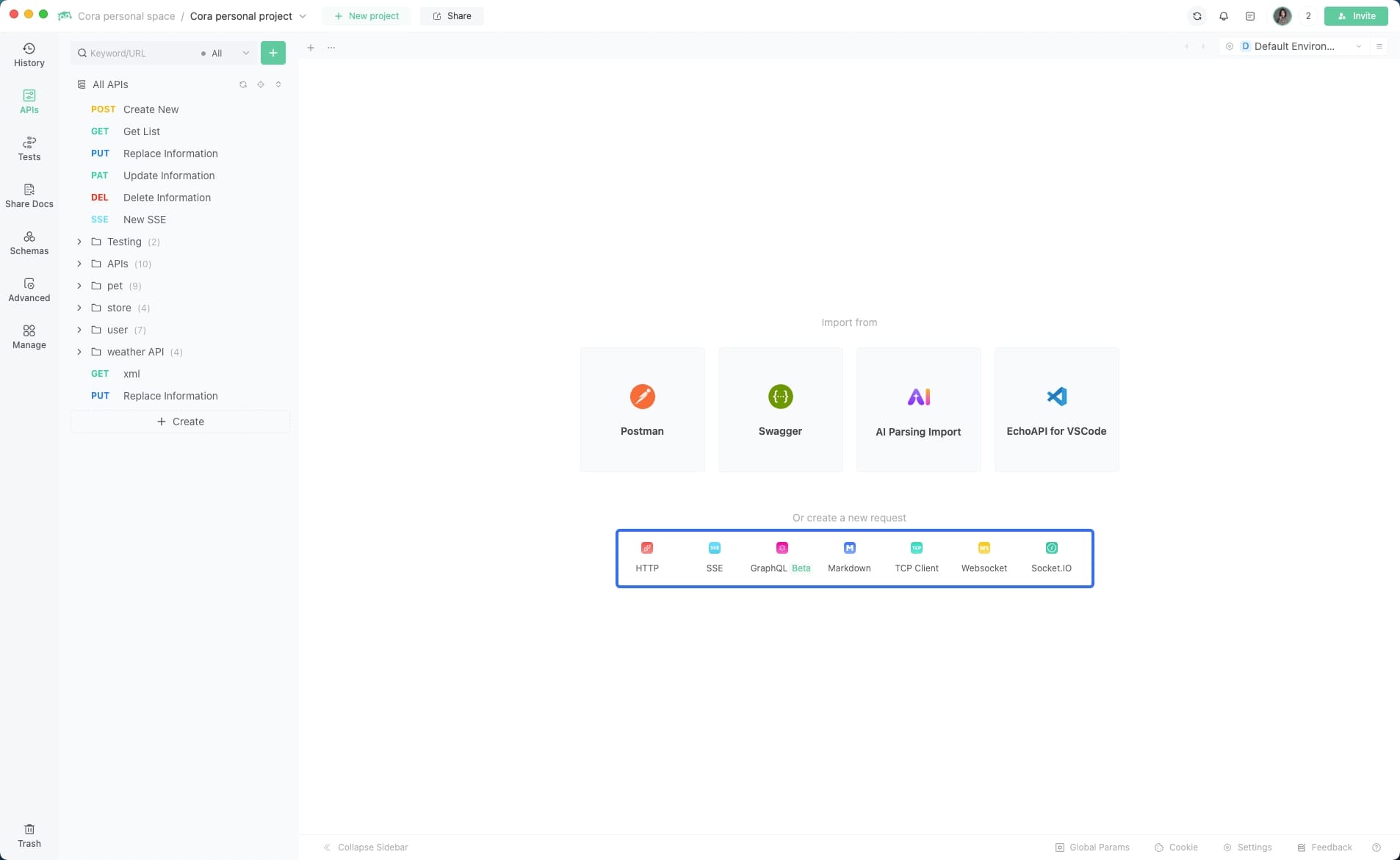7 Essential API Protocols Every Developer Should Know
In this article, we explore the crucial protocols supported by EchoAPI, highlighting their unique features and applications. Understanding these protocols will empower developers to enhance communication and integration between software applications in today’s fast-paced development landscape.
In the rapidly changing world of software development, Application Programming Interfaces (APIs) are crucial for enabling smooth communication between diverse applications. As we analyze the state of APIs, it's essential to understand the protocols that developers rely on for efficient interaction.
This article delves into the key features and capabilities of EchoAPI, showcasing its support for prominent protocols: HTTP, SSE, GraphQL, TCP, WebSocket, Socket.IO, and WebService. Let’s examine the unique aspects and use cases for each protocol and how EchoAPI enhances your development experience.
1. HTTP (Hypertext Transfer Protocol)
HTTP is the foundation of data communication on the web. It is not merely a protocol; it's a set of rules that govern how messages are formatted and transmitted. HTTP is central to RESTful API design and is widely used due to its simplicity and effectiveness.
HTTP Methods:
Clients utilize various HTTP methods to interact with resources. Examples include:
- GET /books: Retrieve a list of all books.
- GET /books/{id}: Get details of a specific book by its ID.
- POST /books: Create a new book.
- PUT /books/{id}: Update an existing book by its ID.
- DELETE /books/{id}: Delete a book by its ID.
Example:
A typical HTTP request to retrieve user information might look like this:
GET https://api.example.com/users/123
2. SSE (Server-Sent Events)
SSE is a powerful technology built on top of HTTP that allows servers to send real-time updates to clients. It is particularly useful for applications requiring constant updates, such as live notifications or stock price feeds.
Use Case:
Imagine your application needs live updates for stock market data. Using SSE, you can efficiently push updates from the server to all connected clients, ensuring they receive the latest information as it happens.
3. GraphQL
GraphQL is a modern query language for APIs that exceeds traditional REST limitations by allowing clients to request the specific data they need. Developed by Facebook, GraphQL offers a flexible, efficient way to interact with data.
Example:
A basic GraphQL schema for posts and authors might look like this:
type Post {
id: ID!
title: String!
body: String!
author: Author!
}
type Author {
id: ID!
name: String!
}
type Query {
posts: [Post!]!
authors: [Author!]!
}
A client can request specific fields, such as:
{
posts {
title
author {
name
}
}
}
4. TCP (Transmission Control Protocol)
TCP facilitates secure and reliable communication between applications over a network. It ensures that data sent from one application is accurately received by another, making it essential for many real-time applications.
Example:
A simple TCP server-client interaction using Python might look like this:
Server (server.py):
import socket
server_socket = socket.socket(socket.AF_INET, socket.SOCK_STREAM)
server_address = ('127.0.0.1', 12345)
server_socket.bind(server_address)
server_socket.listen(5)
while True:
client_socket, client_address = server_socket.accept()
data = client_socket.recv(1024)
client_socket.send(b"Hello, client!")
client_socket.close()
5. WebSocket
WebSocket is a protocol that provides full-duplex communication between a client and server, allowing for real-time data exchange. Unlike traditional HTTP, it maintains a persistent connection, making it ideal for applications requiring instant updates.
Example:
A basic JavaScript WebSocket client might look like this:
const socket = new WebSocket("wss://example.com/socket");
socket.addEventListener("open", () => {
socket.send("Hello, Server!");
});
socket.addEventListener("message", (event) => {
console.log(`Received message from server: ${event.data}`);
});
6. Socket.IO
Socket.IO builds on WebSocket technology, adding a layer of support for real-time applications. It facilitates easier event-based communication between clients and servers, making it suitable for chat applications, online games, and collaborative editing tools.
7. WebService
WebServices encompass a range of technologies that allow different applications to communicate over the internet. They can use various protocols, such as SOAP or REST, enabling integration across diverse platforms and programming languages.
EchoAPI: Your Comprehensive API Solution
EchoAPI excels as a versatile tool supporting multiple protocols, providing developers with a one-stop solution for API design, development, testing, and management. Whether you’re creating an HTTP-based REST API, implementing real-time communication with WebSocket, or utilizing the dynamic capabilities of GraphQL, EchoAPI has you covered.

Conclusion
EchoAPI stands out as an all-in-one API management solution, integrating the capabilities of established tools like Postman, Swagger, and JMeter into a unified platform. By embracing HTTP, SSE, GraphQL, TCP, WebSocket, Socket.IO, and WebService, EchoAPI empowers developers to streamline their workflow, making it easier to manage and optimize diverse APIs without the need for multiple specialized tools.
In the evolving landscape of API development, choosing the right tools and protocols is essential to successfully navigate the complexities of modern software systems. With EchoAPI, you can focus on building innovative applications that meet the demands of today’s digital environment.




 EchoAPI for VS Code
EchoAPI for VS Code

 EchoAPI for IntelliJ IDEA
EchoAPI for IntelliJ IDEA

 EchoAPl-Interceptor
EchoAPl-Interceptor

 EchoAPl CLI
EchoAPl CLI
 EchoAPI Client
EchoAPI Client API Design
API Design
 API Debug
API Debug
 API Documentation
API Documentation
 Mock Server
Mock Server








